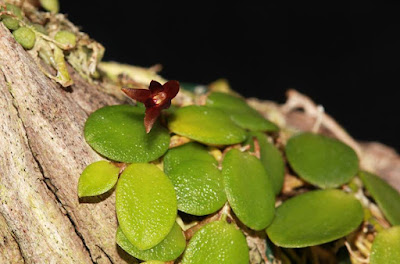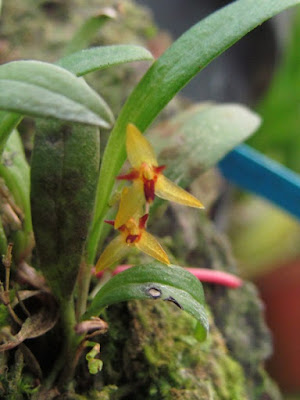Anathallis lewisiae - Lewis's Anathallis flowers are patent, red-brown in color; sepal's bases are yellow...
Anathallis lewisiae also called as Lewis's Anathallis, Panmorphia lewisiae, Pleurothallis lewisiae, Specklinia lewisiae, is a species of the genus Anathallis. This species was described by Rodolfo Solano Gómez and Miguel Ángel Soto Arenas in 2002.
ANATHALLIS LEWISIAE - LEWIS'S ANATHALLIS DESCRIPTION
Anathallis lewisiae is native to Belize, Costa Rica, Guatemala, Honduras, Mexico Gulf, Mexico Southeast, Mexico Southwest, Panamá. It is found growing on the bark of trunks (clinging very well to it) in lowland rain forest at elevations of 0-750 meters above sea level.
It is a small sized, hot to warm creeping epiphyte with reclining to ascending, 0.2 cm long ramicauls that are enveloped by a muriculate, tubular sheath. The single leaf is apical, erect, thickly coriaceous, more or less prostrate, overlapping, minutely subverrucose, elliptical, obtuse, cuneate below into the sessile base, 0.6-1.8 cm long.
Lewis's Anathallis blooms in summer and the fall from the slender, sublax, subsecund, 0.3-0.7 cm long, successively 3 to 6 flowered inflorescence that arising from near the apex of the ramicaul with acute, muriculate floral bracts. The flowers are patent, red-brown in color; sepal's bases are yellow. Lateral sepals are connate near the base. Petals are ligulate, with obtuse apex. Lip is oblong, with rounded apex and a triangular lobe on each side; disc is verrucose between the base and the lateral lobes, with a verrucose callus from the base to the apex. Column is arched and nailed, with a short foot and a winged apex.
ANATHALLIS LEWISIAE - LEWIS'S ANATHALLIS CARE AND CULTURE
Cultural information should only be used as a guide, and should be to be adapted to suit you. Your physical location; where you grow your plants, how much time you have to devote to their care, and many other factors, will need to be taken into account. Only then can you decide on the cultural methods that best suit you and your plants.
Light:
Anathallis lewisiae needs a light level of 12000-18000 lux. The light should be filtered or dispersed, and the plants should not be exposed to direct sunlight in the afternoon hours. Strong air movement should be ensured all the time.
Temperature:
In summer, the average day temperature is 27-29 °C, and the average night temperature is 21-23 °C, with a daily amplitude of 6-8 ° C. In winter, the average day temperature is 25-26 °C, and the average night temperature is 18-20 °C, with a daily amplitude of 6-8 ° C.
Humidity:
Lewis's Anathallis needs the humidity of probably around 80% throughout the year. Too dry air has a negative effect on the development of the plant: its growth is inhibited, and the leaves begin to turn yellow and dry out. The higher temperature, the higher the humidity should be, and the higher the humidity, the more often and longer it is necessary to ventilate the room where the plants are contained, otherwise the probability of rotting and various kinds of fungal diseases. Good air movement is essential while the plants are in leaf and growing.
Substrate, growing media:
Anathallis lewisiae can be grown in small pots or baskets or mounted on pieces of tree ferns with peat moss pillows around the roots, with high humidity ensured and daily watering in the summer, during the dry and hot periods it may be necessary to water several times a day.
These plants are also grown in pots or baskets using a very loose, fast-drying substrate, such as fir bark or chopped tree fern fibers. Also, the materials that release the substrate but often retain a portion of the moisture, e.g. perlite, are often added to such a mixture. The addition of charcoal also improves the permeability of the substrate, and also protects against acidification.
Repotting:
Lewis's Anathallis react badly to any manipulations, so they should be repotted or divided only when absolutely necessary. However, because these plants do not tolerate also the decaying soil around the roots, they should be repotted immediately when the substrate begins to decompose. Therefore, it is recommended to choose a substrate such as tree fern fibers, because these are slowly decomposed. If repotting is done at the time when new roots begin to appear, the plant will be accepted and rooted in the shortest possible time. If the plant was divided, it may take up to two years to recover.
Watering:
Anathallis lewisiae should be watered abundantly during the period of intensive growth from the summer to the beginning of winter, but excellent drainage should be ensured so that the ground around the roots is never desiccated or soggy.
Fertilizer:
During the active growth, Lewis's Anathallis should be fertilized every week 1/4-1/2 of the recommended dose of fertilizer for orchids. From spring to mid-summer, you can use fertilizer enriched with nitrogen, then switching to phosphorus-enriched fertilizer in late summer and autumn.
Rest period:
Anathallis lewisiae need less water in the winter, especially if they grow under the conditions of a dark, short day that occurs in moderate latitudes. However, these plants should never be completely dried up. Fertilization should be reduced or eliminated until new growths appear and a more abundant spring watering begins.















COMMENTS